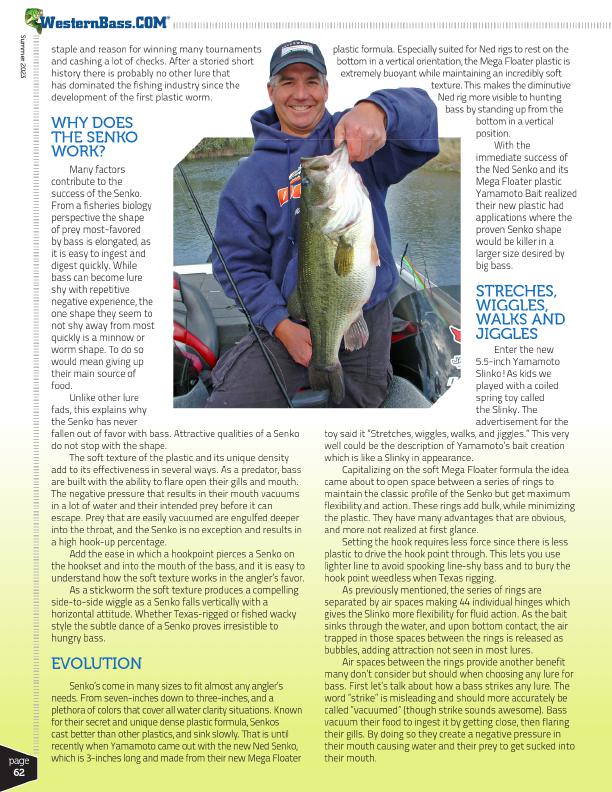
®
Summer 2023
page 62
staple and reason for winning many tournaments and cashing a lot of checks. After a storied short history there is probably no other lure that has dominated the fishing industry since the development of the first plastic worm.
WHY DOES THE SENKO WORK?
Many factors contribute to the success of the Senko. From a fisheries biology perspective the shape of prey most-favored by bass is elongated, as it is easy to ingest and digest quickly. While bass can become lure shy with repetitive negative experience, the one shape they seem to not shy away from most quickly is a minnow or worm shape. To do so would mean giving up their main source of food.
Unlike other lure fads, this explains why the Senko has never fallen out of favor with bass. Attractive qualities of a Senko do not stop with the shape.
The soft texture of the plastic and its unique density add to its effectiveness in several ways. As a predator, bass are built with the ability to flare open their gills and mouth. The negative pressure that results in their mouth vacuums in a lot of water and their intended prey before it can escape. Prey that are easily vacuumed are engulfed deeper into the throat, and the Senko is no exception and results in a high hook-up percentage.
Add the ease in which a hookpoint pierces a Senko on the hookset and into the mouth of the bass, and it is easy to understand how the soft texture works in the angler’s favor.
As a stickworm the soft texture produces a compelling side-to-side wiggle as a Senko falls vertically with a horizontal attitude. Whether Texas-rigged or fished wacky style the subtle dance of a Senko proves irresistible to hungry bass.
EVOLUTION
Senko’s come in many sizes to fit almost any angler’s needs. From seven-inches down to three-inches, and a plethora of colors that cover all water clarity situations. Known for their secret and unique dense plastic formula, Senkos cast better than other plastics, and sink slowly. That is until recently when Yamamoto came out with the new Ned Senko, which is 3-inches long and made from their new Mega Floater
plastic formula. Especially suited for Ned rigs to rest on the bottom in a vertical orientation, the Mega Floater plastic is
extremely buoyant while maintaining an incredibly soft
texture. This makes the diminutive
Ned rig more visible to hunting
bass by standing up from the
bottom in a vertical
position.
With the
immediate success of
the Ned Senko and its
Mega Floater plastic
Yamamoto Bait realized
their new plastic had
applications where the
proven Senko shape
would be killer in a
larger size desired by
big bass.
STRECHES,
WIGGLES,
WALKS AND
JIGGLES
Enter the new
5.5-inch Yamamoto
Slinko!As kids we
played with a coiled
spring toy called
the Slinky. The
advertisement for the toy said it “Stretches, wiggles, walks, and jiggles.” This very well could be the description of Yamamoto’s bait creation which is like a Slinky in appearance.
Capitalizing on the soft Mega Floater formula the idea came about to open space between a series of rings to maintain the classic profile of the Senko but get maximum flexibility and action. These rings add bulk, while minimizing the plastic. They have many advantages that are obvious, and more not realized at first glance.
Setting the hook requires less force since there is less plastic to drive the hook point through. This lets you use lighter line to avoid spooking line-shy bass and to bury the hook point weedless when Texas rigging.
As previously mentioned, the series of rings are separated by air spaces making 44 individual hinges which gives the Slinko more flexibility for fluid action. As the bait sinks through the water, and upon bottom contact, the air trapped in those spaces between the rings is released as bubbles, adding attraction not seen in most lures.
Air spaces between the rings provide another benefit many don’t consider but should when choosing any lure for bass. First let’s talk about how a bass strikes any lure. The word “strike” is misleading and should more accurately be called “vacuumed” (though strike sounds awesome). Bass vacuum their food to ingest it by getting close, then flaring their gills. By doing so they create a negative pressure in their mouth causing water and their prey to get sucked into their mouth.